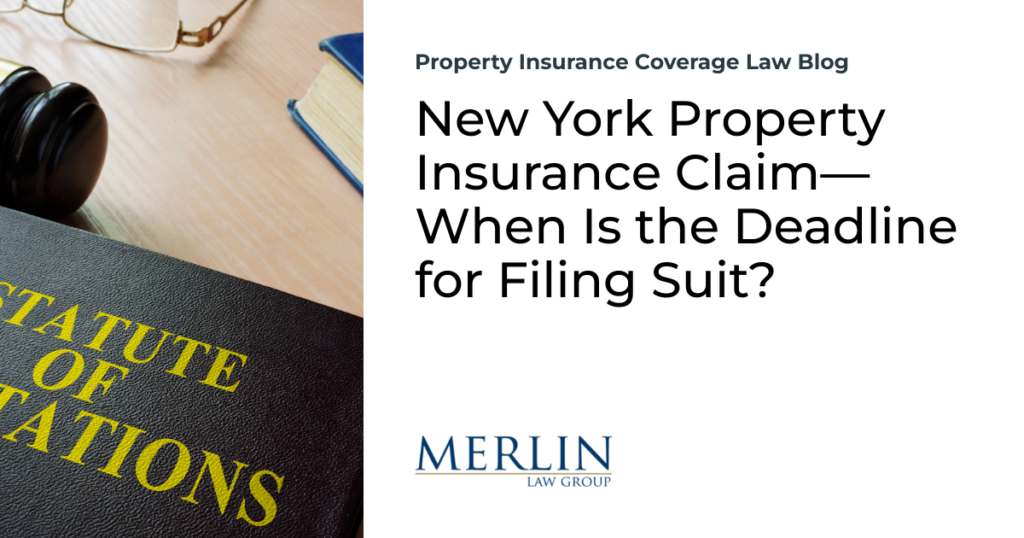New York Property Insurance Claim—When Is the Deadline for Filing Suit?

In a decision made last week, a New York federal judge applied New York suit limitations law allowing a policyholder to file a lawsuit more than seven years after her apartment suffered water damage.1 Here are the relevant facts recited by the court:
In early 2014, Plaintiff learned that her New York City apartment had suffered severe water damage. She promptly reported the damage to Pacific Indemnity, pursuant to the conditions of her property insurance policy (the ‘Policy’). But prompt notice to the insurer was only one condition. To recover on her claim, Plaintiff was also required to take reasonable means to protect her property from further damage; prepare an inventory of damaged property; be examined under oath, if requested; and submit, within sixty days of the request, a signed, sworn proof of loss.
Plaintiff complied with all these requirements. But Pacific Indemnity spent years delaying the claims process, which had costly consequences for Plaintiff. In particular, the Policy provides that the insured ‘cannot abandon any property to us unless we agree to accept it, or to a third party unless we agree.’ In effect, this required Plaintiff to keep all of her damaged property until Pacific Indemnity agreed that she could dispose of it. By delaying several years before inspecting Plaintiff’s damaged property, Pacific Indemnity forced Plaintiff to incur years of unnecessary storage costs.
In 2021, Pacific Indemnity ultimately denied coverage for Plaintiff’s property damage, citing Plaintiff’s failure to comply with the required conditions as a reason for nonpayment. In so doing, Pacific Indemnity invoked the condition in the policy which provides that the insured ‘agree[s] not to bring legal action against us unless you have first complied with all conditions of this Policy.’ The Policy also states that the insured ‘agree[s] to bring any action against us within two years after a loss occurs.’ The Policy does not define the term ‘loss.’
Plaintiff commenced this action in February 2022….
Based on these facts and the specific policy language, the judge ruled that the policyholder timely filed the lawsuit under New York law:
New York law generally allows parties to a contract six years to file suit for an alleged breach of contract.3 C.P.L.R. § 213(2). ‘However, parties to a contract may agree to shorter limitations periods, which are normally enforceable when they are reasonable and in writing.’ Vitrano v. State Farm Ins. Co., No. 08-cv-103, 2008 WL 2696156, at *2 (S.D.N.Y. July 8, 2008) (citing John J. Kassner & Co. v. City of New York, 46 N.Y.2d 544, 551 (1979)). ‘Dismissal is appropriate where suit is initiated beyond the contractual limitations period.’ Polcom USA, LLC v. Affiliated FM Ins. Co., 551 F. Supp. 3d 290, 294 (S.D.N.Y. 2021).
The Policy at issue here contains a contractual limitations period which provides that the insured must ‘agree to bring any action against [Pacific Indemnity] within two years after a loss occurs.’ The term ‘loss’ is not defined in the policy. However, Pacific Indemnity argues that it is plain from a reading of the whole Policy and the use of the word ‘loss’ throughout that suit must be brought within two years of when the underlying damage occurs. Pacific Indemnity contends that the action is therefore untimely because it was brought roughly eight years from when the water damage occurred. This argument is foreclosed by precedent.
In Fabozzi v. Lexington Insurance Company., 601 F.3d 88 (2d Cir. 2010), the Second Circuit addressed language in an insurance contract which required the plaintiffs to bring suit ‘within two years after the date of the loss.’ As is the case here, the insurance company argued that when viewing the policy as a whole, and the use of the word ‘loss’ throughout, the limitations provision clearly applies from the date that the damage occurred. Rejecting that argument, the Second Circuit explained that the term ‘loss’ was not defined in the policy and that ‘[a]t most, the other uses of ‘loss’ in the contract render that term ambiguous.’ This ambiguity necessarily defeated the insurer’s interpretation, the Second Circuit continued, because ‘it is well-settled law that where an insurer has drafted the policy . . . any ambiguity in the policy should be resolved in favor of the insured.’ As a result, the court concluded that the limitations period ran from the date that the insured’s claim accrued—which, under New York law, generally occurs at the time of the breach.
The policyholder in this case was fortunate to have that policy language. We have warned that New York policies often have a 12-month deadline to file suit, as noted in New York Statute of Limitations Can Be Contractually Shortened to as Little as One Year From Date Of Loss, and New York Statute of Limitations and the Effect of the COVID-19 Closures.
Thought For The Day
Dreams don’t have deadlines. I’m thinking of doing bigger and better things and having more fun with it.
—LL Cool J
1 Hochfelder v. Pacific Indemnity Co., No. 1:22-cv-2012 (S.D. NY Mar. 9, 2023).







